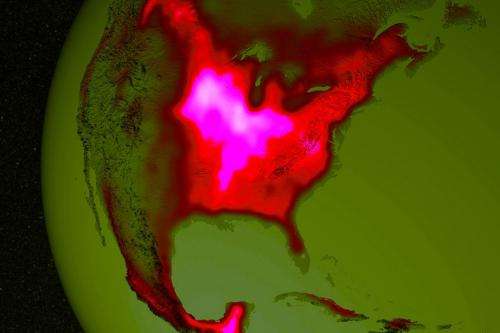Space-based crop monitoring a key to food security

(Phys.org) —To face the challenges of climate change, and human impact, world food production needs to double by 2050 making accurate and reliable estimates of agricultural productivity – measured as global gross primary productivity (GPP) – a global priority.
An international collaboration, involving UTS remote sensing specialist, Professor Alfredo Huete, has made this goal more achievable by using a breakthrough methodology that has the potential to significantly improve the monitoring of global crop productivity.
The results of the research, recently published in Proceedings of the National Academy of Sciences (PNAS), show that new space-based observations of photosynthesis, using chlorophyll fluorescence data, will provide more reliable projections of agricultural productivity and the impact of climate on crop yields.
The research outcomes are especially timely because new satellite missions in 2014 and 2015 are expected to further improve the potential for this type of monitoring and provide unique data sets for the better management of critical agricultural resources.
Currently the best estimates for GPP use direct measurement of carbon dioxide exchange from a series of micrometeorological instruments attached to towers over agricultural fields. However these flux towers tend to sample relatively small areas and are concentrated in North America and Europe. To overcome these shortcomings scientists are now utilising advances in spectroscopy to monitor photosynthesis in terrestrial plants from space, with highly encouraging results.
"Photosynthesis is the primary source of energy for all life on Earth and generally speaking this process places an upper limit on the supply of food and fuels from our agricultural systems. However it has been very difficult to assess photosynthesis rates over the breadbaskets of the world until now," Professor Huete says.
The authors of the paper said the research gives a unique global perspective on crop photosynthesis by monitoring sun-induced chlorophyll fluorescence (SIF) across the world's croplands. This shows that remotely sensed SIF data provides a direct measure of the productivity of cropland and grassland ecosystems.
Professor Huete explained that SIF is a by-product of photosynthesis that is emitted as an electromagnetic signal in a particular "spectral window" of 650-850 nanometres. Improved instrumentation aboard satellite platforms associated with the Global Ozone Monitoring Experiment-2, for example, means that SIF monitoring can now be done at higher resolution, more frequently over a much bigger area of the world and without the need for additional information or complicated modelling.
"This is really a breakthrough because SIF data is giving us realistic estimates of photosynthetic uptake rates over large cropping areas such as the American corn belt and the intensively fertilised Indo-Gangetic Plains. This means we can improve current models of the global carbon cycle which tend to substantially underestimate productivity in these regions."
More information: Luis Guanter, Yongguang Zhang, Martin Jung, Joanna Joiner, Maximilian Voigt, Joseph A. Berry, Christian Frankenberg, Alfredo R. Huete, Pablo Zarco-Tejada, Jung-Eun Lee, M. Susan Moran, Guillermo Ponce-Campos, Christian Beer, Gustavo Camps-Valls, Nina Buchmann, Damiano Gianelle, Katja Klumpp, Alessandro Cescatti, John M. Baker, and Timothy J. Griffis. "Global and time-resolved monitoring of crop photosynthesis with chlorophyll fluorescence." PNAS 2014 111 (14) E1327-E1333; published ahead of print March 25, 2014, DOI: 10.1073/pnas.1320008111
Journal information: Proceedings of the National Academy of Sciences
Provided by University of Technology, Sydney




















